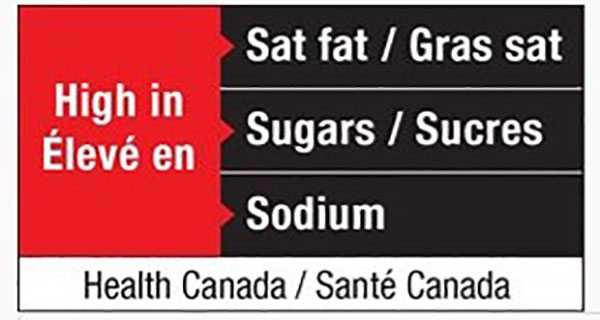 When it comes to food, the current federal government is big on consultations. Health Canada recently launched online public discussions and consumer-oriented research to find the best front-of-package labelling formula.
When it comes to food, the current federal government is big on consultations. Health Canada recently launched online public discussions and consumer-oriented research to find the best front-of-package labelling formula.
Four models have been presented – Health Canada appears to want to keep its options open (although all the logos look the same). Saturated fats, sugar and sodium are targeted, and are to be predominantly placed on the labels of all packaged goods sold in Canada.
The suggested label policy appears to be straightforward. All products that include more than 15 per cent of the daily recommended consumption of each ingredient must list them at the top of the package. Raw commodities with natural ingredients, such as maple syrup or meat products, will be exempt, which makes perfect sense.
Front-of-package nutrition symbols and notices should require minimal prior knowledge to use. The label needs to be clear and simple, which is exactly what Health Canada is proposing. But simplicity doesn’t necessarily guarantee a confusion-free experience.
Although consumers pay attention to sugar, fat and sodium, they may rely on this data to the exclusion of others. (You could argue that the more we eat sugar, fat and sodium, the lower our grasp of what’s healthy.)
At the same time, Health Canada appears to overvalue some nutrients. This may lead consumers away from certain nutrients and encourage the purchase of others. For example, certain packaged cheeses may be high in fat but are rich in important nutrients such as vitamins C and D, and calcium.
One good step is that calories aren’t emphasized. Studies suggest that people focus too much on calories and that can stop them from selecting a healthier product.
Ultimately, the accuracy of the nutritional labels should be underscored. Many studies show that sodium and fats are often underreported. These ingredients should be more closely monitored to make sure labels are accurate. This would provide tangible health benefits, and reduce fraudulent food products and cases of adulteration.
Simplicity has its challenges and limitations, and industry has expressed concerns and even some level of opposition. In part, that’s because labelling rules could force food manufacturers to reformulate decades-old food products or discontinue entire product lines. It will be interesting to see how industry adapts.
Given the pressures of everyday life, Health Canada’s plan is likely the most effective way to help consumers.
But for the new rules to be effective, the labels should have colour and words to indicate levels. Studies show that the traffic light system is the best model: consumers exposed to a green-yellow-red system are three times more likely to identify healthier food products than consumers exposed to other systems.
Over time, consumers understand that the health value of food products can be assessed in relative terms. But Health Canada’s planned approach is dangerously binary – it doesn’t allow for interpretation and enhanced nutritional literacy.
Some critics suggest the new plan doesn’t go far enough. Several advocate that cartoons and colourful packaging be banned because they seek to engage children. However, clear and unassuming front-of-package labels would provide parents with the information and tools to decide for themselves and their children.
Giving quality information to consumers or overprotecting society is a delicate balance. Overprotection rarely entices consumers to become better educated about important issues such as proper nutrition. New policies should encourage consumers to make healthier choices, not necessarily protect them from themselves.
Short of a traffic light approach, Health Canada appears to be striking the right balance between labelling simplicity and effectiveness.
And there appears to be some international momentum towards such labelling policies, so Canada is not a lone wolf. Several countries, including Australia, are looking at making changes simultaneously. That means importers will see this new approach as less of an obstacle.
For our own food security and economic welfare, uniformity must be kept in mind as we try to empower consumers with more information about what they eat.
Sylvain Charlebois is dean of the Faculty of Management and a professor in the Faculty of Agriculture at Dalhousie University and author of Food Safety, Risk Intelligence and Benchmarking, published by Wiley-Blackwell (2017).
The views, opinions and positions expressed by columnists and contributors are the author’s alone. They do not inherently or expressly reflect the views, opinions and/or positions of our publication.

